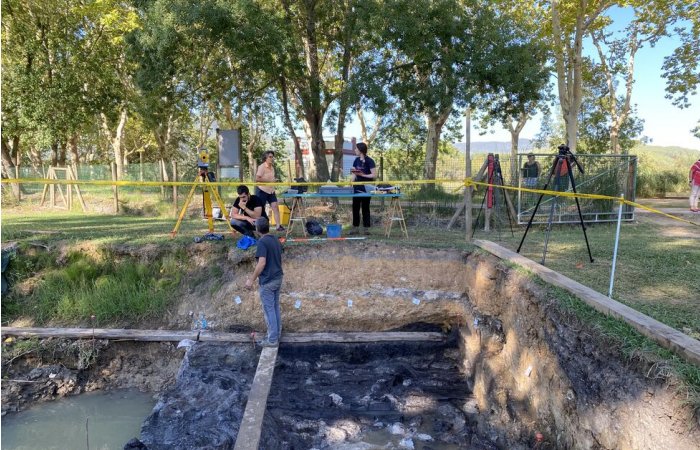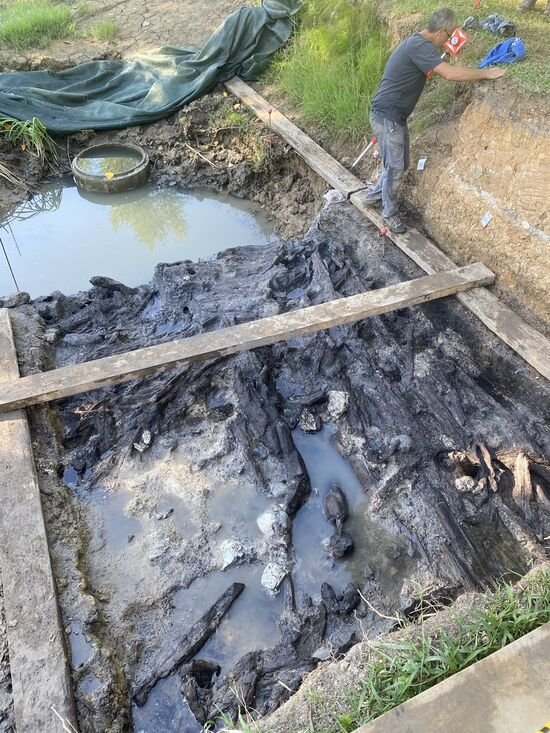Conny Waters – AncientPages.com – Archaeologists excavating at La Draga de Banyoles, an Early Neolithic lakeshore site in Spain, have uncovered well-preserved 7,300-year-old wooden cabins.
The ancient structures are in excellent condition and make it possible to gain knowledge about farming communities that settled in L’Estany at the beginning of the Neolithic, about 7,200 years ago.

Credit: IPHES – Catalan Insтιтute of Human Paleoecology and Social Evolution
Archaeological discoveries in other parts show wood can survive much longer than most think. For example, the world’s oldest wooden structure discovered recently in Zambia is worth mentioning. Excavation of well-preserved wood at the archaeological site of Kalambo Falls dating back at least 476,000 years and predates the evolution of our species, Homo sapiens.
Looking in another direction, we learn that the Boxford Timber discovered in Berkshire is Britain’s oldest carved wood.
Wood has archaeological value and has been a vital resource to past human societies.
At La Draga, scientists from several universities have worked together and focused on the northernmost area of the site, the so-called sector B, which has the particularity of having better conditions for the conservation of organic matter. So far, it is in this sector where the most apparent architectural evidence of the wooden cabins of the ancient settlers of La Draga has appeared and where a more significant number of tools and utensils made of wood and plant fibers have also been found.
“The work at the La Draga site has made it possible to document structural elements of wooden constructions in a very good state of conservation. They are mainly large wooden planks over three meters long that occupy practically the entire surface of the excavated area.
The excavation process should allow us to make very precise interpretations of the shape of these huts, the construction techniques and the time of their construction, and their relationship with areas excavated in previous campaigns,” the co-directors of the research project Toni Palomo and Raquel Piqué (UAB) and Xavier Terradas (CSIC-IMF Barcelona) said in a press release.
At the same time, the campaign has carried out two archaeological and paleological prospecting actions on the western shore of the Lake, both terrestrial and underwater. On the one hand, soundings have been made on the west shore of Banyoles Lake, within the municipality of Porqueres. In this case, the objective is to obtain new sedimentological and paleoenvironmental data that should allow the La Draga team of researchers to reconstruct the environmental dynamics of Banyoles Lake during the Holocene and verify the possible presence of other prehistoric occupations in this place.

Credit: IPHES – Catalan Insтιтute of Human Paleoecology and Social Evolution
“The soundings carried out have allowed us to document signs of great interest to reconstruct what the environment was like in prehistoric times,” comments Dr. Jordi Revelles, Juan de la Cierva postdoctoral researcher at IPHES-CERCA. The current study also helped to “contextualize findings made in previous surveys when signs of use of the space were documented around 5,000 years ago, more than 2,000 years later than the town of La Draga”, he adds.
See also: More Archaeology News
Scientists emphasize underwater surveys have also been carried out on the lake’s western shore, in the area between Punta Freixenet and Punta Cuaranya. The work has made it possible to document large areas of peaty sediment with a significant presence of preserved organic matter such as, for example, wood remains. The analysis of the samples carried out allows us to understand better the dynamics of the prehistoric and historical settlement of the Lake.
Written by Conny Waters – AncientPages.com Staff Writer





